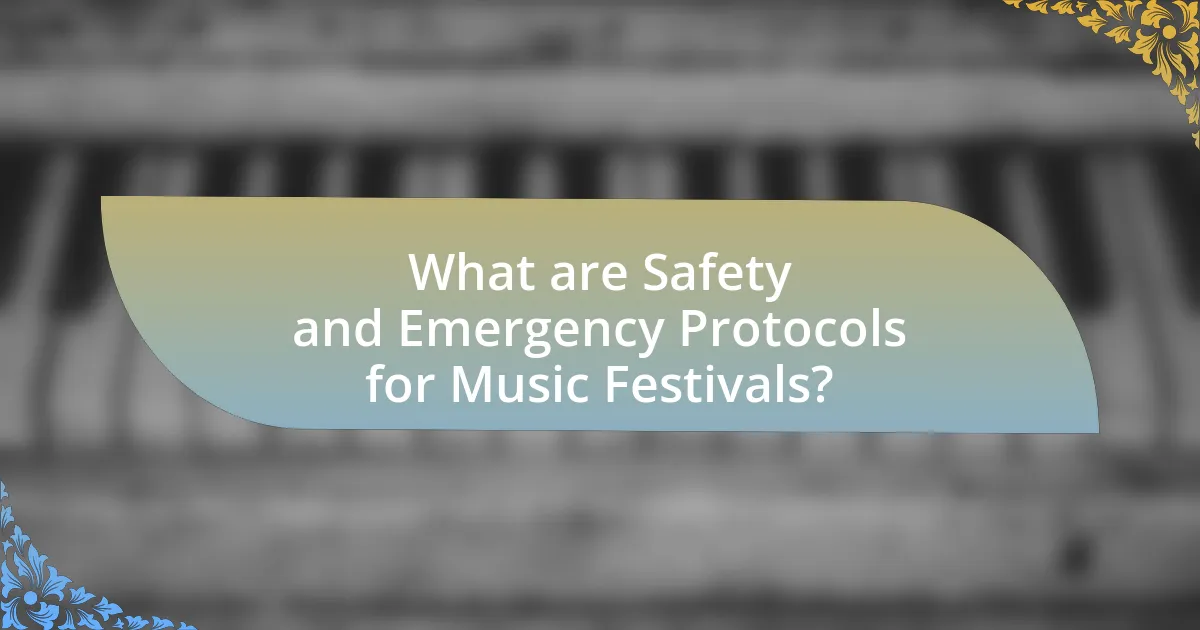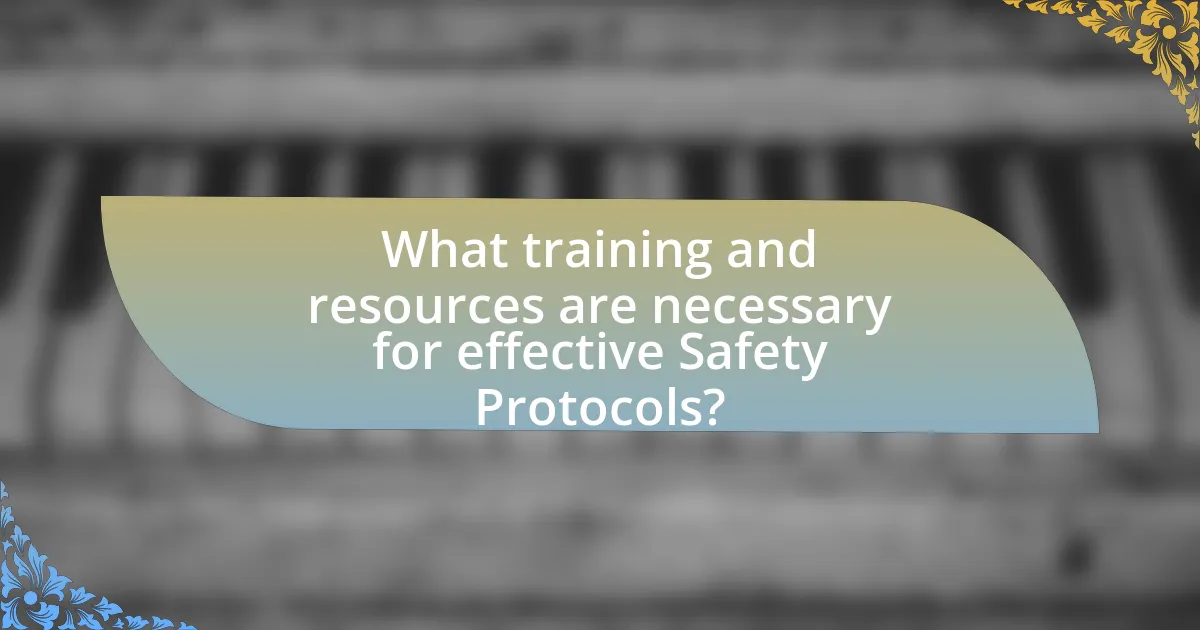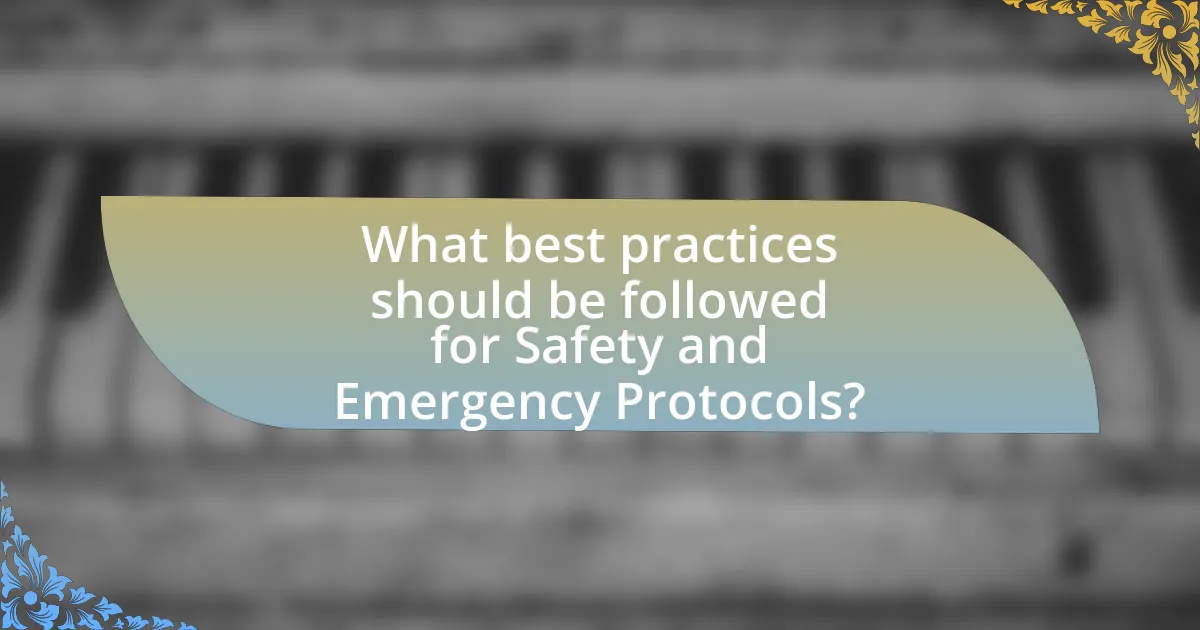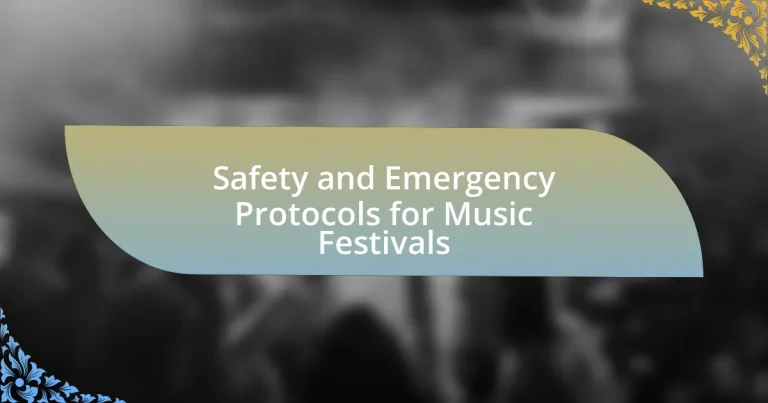Safety and emergency protocols for music festivals are critical measures designed to protect attendees and staff from potential hazards. These protocols encompass crowd management, medical assistance, and evacuation plans, ensuring a rapid response to emergencies such as medical incidents, severe weather, or security threats. Key components include risk assessments, communication systems, and trained personnel, all aimed at minimizing risks and enhancing safety. The article examines the importance of these protocols, common risks faced by attendees, and best practices for effective implementation, highlighting the role of security personnel and the necessity of thorough training and resources.

What are Safety and Emergency Protocols for Music Festivals?
Safety and emergency protocols for music festivals include measures such as crowd management, medical assistance, and evacuation plans. These protocols are designed to ensure the safety of attendees and staff during the event. For instance, crowd management strategies involve monitoring audience density and controlling entry and exit points to prevent overcrowding, which can lead to dangerous situations. Medical assistance is typically provided through on-site medical teams equipped to handle emergencies, including first aid stations and ambulances. Additionally, evacuation plans outline clear procedures for safely exiting the venue in case of emergencies, such as severe weather or security threats. These protocols are essential for minimizing risks and ensuring a safe environment, as evidenced by the implementation of such measures in large-scale events like Coachella and Glastonbury, which have established guidelines to address potential hazards effectively.
Why are Safety and Emergency Protocols essential at Music Festivals?
Safety and emergency protocols are essential at music festivals to protect attendees from potential hazards and ensure a rapid response to emergencies. These protocols help manage large crowds, mitigate risks such as medical emergencies, fires, or severe weather, and provide clear guidelines for evacuation or assistance. For instance, the 2017 Route 91 Harvest Festival shooting highlighted the need for effective emergency plans, as the lack of preparedness contributed to chaos and confusion. Implementing comprehensive safety measures, including trained security personnel and clear communication systems, significantly enhances the overall safety of festival-goers.
What risks do attendees face at Music Festivals?
Attendees at music festivals face several risks, including overcrowding, substance abuse, medical emergencies, and environmental hazards. Overcrowding can lead to dangerous situations such as trampling or difficulty in evacuation during emergencies. Substance abuse is prevalent at festivals, increasing the likelihood of health crises, including overdoses. Medical emergencies can arise from dehydration, heat exhaustion, or allergic reactions, necessitating immediate medical attention. Environmental hazards, such as extreme weather conditions or inadequate sanitation, can also pose significant risks to attendees’ safety. According to a study published in the Journal of Environmental Health, incidents of heat-related illnesses at outdoor festivals can increase by 30% during high-temperature events, highlighting the importance of awareness and preparedness for these risks.
How do Safety and Emergency Protocols mitigate these risks?
Safety and emergency protocols mitigate risks at music festivals by establishing clear guidelines for managing potential hazards, ensuring rapid response to emergencies, and promoting attendee awareness. These protocols include measures such as crowd control strategies, medical response teams, and evacuation plans, which collectively reduce the likelihood of incidents escalating into serious situations. For instance, the implementation of a comprehensive medical response plan can decrease the response time to medical emergencies, thereby potentially saving lives. Additionally, regular training and drills for staff enhance preparedness, as evidenced by studies showing that well-prepared teams can effectively manage crises, reducing injury rates by up to 30%.
What are the key components of Safety and Emergency Protocols?
The key components of Safety and Emergency Protocols for music festivals include risk assessment, emergency response plans, communication systems, crowd management strategies, and training for staff and volunteers. Risk assessment identifies potential hazards specific to the festival environment, such as weather conditions or crowd dynamics. Emergency response plans outline procedures for various scenarios, including medical emergencies, evacuations, and natural disasters. Effective communication systems ensure that information can be relayed quickly among staff, emergency services, and attendees. Crowd management strategies help maintain order and safety during the event, addressing issues like entry and exit points. Training for staff and volunteers equips them with the necessary skills to implement these protocols effectively, ensuring a safe environment for all participants.
What roles do security personnel play in these protocols?
Security personnel play a critical role in safety and emergency protocols for music festivals by ensuring the safety of attendees, managing crowd control, and responding to emergencies. Their responsibilities include monitoring the venue for potential threats, enforcing rules and regulations, and coordinating with local law enforcement and emergency services. For instance, during the 2017 Route 91 Harvest Festival shooting, security personnel were pivotal in evacuating attendees and providing immediate assistance, highlighting their importance in crisis situations.
How is crowd management integrated into Safety Protocols?
Crowd management is integrated into safety protocols by establishing clear guidelines for monitoring and controlling audience behavior during events. These protocols include the deployment of trained personnel to manage crowd flow, the use of barriers to direct movement, and the implementation of emergency evacuation plans. For instance, the National Fire Protection Association (NFPA) recommends that venues conduct crowd management training and drills to ensure preparedness for emergencies, which enhances overall safety. Additionally, data from the International Association of Venue Managers indicates that effective crowd management can reduce the risk of incidents by up to 30%, demonstrating its critical role in safety protocols.
How are emergency situations identified and addressed?
Emergency situations at music festivals are identified through a combination of real-time monitoring, communication from attendees and staff, and predefined risk assessment protocols. Event organizers utilize surveillance systems, crowd management techniques, and trained personnel to detect signs of emergencies such as medical incidents, security threats, or severe weather conditions.
Addressing these situations involves activating emergency response plans, which include coordinating with local emergency services, implementing evacuation procedures, and providing immediate medical assistance. For instance, the National Fire Protection Association emphasizes the importance of having a comprehensive emergency action plan that outlines specific roles and responsibilities for staff during an emergency, ensuring a swift and organized response.
What types of emergencies are most common at Music Festivals?
The most common emergencies at music festivals include medical emergencies, crowd-related incidents, and weather-related issues. Medical emergencies often involve dehydration, heat exhaustion, or substance-related health crises, which are prevalent due to the high-energy environment and prolonged exposure to the elements. Crowd-related incidents can lead to injuries from surges or stampedes, particularly during peak moments of performances. Additionally, severe weather events, such as storms or extreme heat, can pose significant risks, necessitating evacuation or shelter protocols. These types of emergencies are documented in safety reports and studies conducted by organizations like the National Association of State Emergency Medical Services Officials, which highlight the need for comprehensive emergency response plans at large gatherings.
How do organizers prepare for medical emergencies?
Organizers prepare for medical emergencies by developing comprehensive emergency response plans that include trained medical personnel, designated first aid stations, and clear communication protocols. These plans are often based on risk assessments that identify potential medical issues specific to the event, such as heat-related illnesses or substance overdoses. For instance, a study by the National Center for Biotechnology Information highlights that having on-site medical teams and accessible emergency services significantly reduces response times and improves outcomes during medical incidents at large gatherings. Additionally, organizers conduct drills and training sessions to ensure that staff are familiar with emergency procedures, further enhancing preparedness for any medical situation that may arise.

What training and resources are necessary for effective Safety Protocols?
Effective safety protocols require comprehensive training in emergency response, risk assessment, and crowd management, along with resources such as first aid kits, communication equipment, and clear signage. Training programs should include certifications in first aid and CPR, as well as simulations of emergency scenarios specific to music festivals. Resources like trained medical personnel on-site, emergency evacuation plans, and access to local emergency services are essential to ensure preparedness. Studies indicate that festivals with well-trained staff and adequate resources significantly reduce incidents and enhance attendee safety.
What training do staff and volunteers receive?
Staff and volunteers receive training focused on safety and emergency protocols specific to music festivals. This training typically includes instruction on crowd management, emergency evacuation procedures, first aid, and communication protocols during emergencies. For instance, organizations often utilize scenario-based training to prepare staff for real-life situations, ensuring they can effectively respond to incidents such as medical emergencies or security threats. This structured approach to training is essential for maintaining a safe environment at music festivals, as evidenced by industry standards and best practices established by organizations like the Event Safety Alliance.
How does training impact the effectiveness of emergency response?
Training significantly enhances the effectiveness of emergency response by equipping responders with the necessary skills and knowledge to act swiftly and efficiently during crises. Well-structured training programs improve decision-making, coordination, and communication among emergency personnel, which are critical during high-pressure situations. For instance, a study by the National Fire Protection Association found that trained responders are 30% more likely to successfully manage emergency incidents compared to untrained individuals. This statistic underscores the importance of training in ensuring that emergency protocols are executed effectively, ultimately leading to better outcomes in life-threatening situations at events like music festivals.
What resources are essential for implementing these protocols?
Essential resources for implementing safety and emergency protocols at music festivals include trained personnel, communication equipment, medical supplies, and emergency response plans. Trained personnel, such as security staff and medical teams, ensure effective management of emergencies. Communication equipment, like radios and mobile devices, facilitates real-time coordination among staff. Medical supplies, including first aid kits and defibrillators, are crucial for addressing health emergencies. Emergency response plans outline procedures for various scenarios, ensuring preparedness and swift action. These resources collectively enhance safety and response capabilities at music festivals.
How do communication systems function during emergencies?
Communication systems function during emergencies by facilitating rapid information exchange among responders, event staff, and attendees. These systems utilize various technologies, including two-way radios, mobile networks, and public address systems, to ensure that critical messages are disseminated quickly and effectively. For instance, during the 2017 Route 91 Harvest Festival shooting, emergency communication protocols were vital in coordinating law enforcement and medical responses, demonstrating the importance of reliable communication systems in crisis situations.
What technologies are used for real-time communication?
Real-time communication technologies include Voice over Internet Protocol (VoIP), WebRTC, and instant messaging platforms. VoIP enables voice communication over the internet, facilitating immediate interaction among festival staff and emergency responders. WebRTC allows for real-time audio, video, and data sharing directly between browsers, enhancing coordination during emergencies. Instant messaging platforms provide quick text-based communication, ensuring that critical information is disseminated rapidly. These technologies are essential for maintaining safety and effective emergency protocols at music festivals, as they enable swift responses to incidents and improve overall communication efficiency.
How is information disseminated to attendees during an emergency?
Information is disseminated to attendees during an emergency through multiple channels, including public address systems, mobile alerts, and on-site staff communication. Public address systems provide real-time announcements to ensure that all attendees receive critical information promptly. Mobile alerts, often sent via festival apps or SMS, allow for direct communication to attendees’ devices, ensuring they are informed even if they are not near a speaker. Additionally, trained on-site staff are positioned throughout the venue to relay information and assist attendees, enhancing the overall effectiveness of the communication strategy during emergencies. These methods are crucial for ensuring attendee safety and facilitating a coordinated response.

What best practices should be followed for Safety and Emergency Protocols?
Best practices for Safety and Emergency Protocols at music festivals include establishing clear communication channels, conducting regular safety drills, and ensuring adequate medical support is available on-site. Clear communication channels, such as two-way radios and public address systems, facilitate quick dissemination of information during emergencies. Regular safety drills prepare staff and volunteers for various scenarios, enhancing their response effectiveness. Additionally, having trained medical personnel and first aid stations ensures immediate care for attendees, which is critical in emergencies. These practices are supported by guidelines from organizations like the National Fire Protection Association, which emphasizes the importance of preparedness and response planning in large gatherings.
How can festival organizers ensure compliance with safety regulations?
Festival organizers can ensure compliance with safety regulations by conducting thorough risk assessments and adhering to local laws and guidelines. This involves identifying potential hazards, evaluating risks, and implementing appropriate safety measures, such as crowd control, emergency medical services, and fire safety protocols. For instance, the National Fire Protection Association (NFPA) provides specific guidelines for event safety that can be referenced to ensure compliance. Additionally, organizers should collaborate with local authorities and emergency services to align their safety plans with community standards and regulations, ensuring a comprehensive approach to safety management.
What are the legal requirements for Safety Protocols at Music Festivals?
The legal requirements for safety protocols at music festivals include compliance with local, state, and federal regulations, which mandate risk assessments, emergency response plans, and crowd management strategies. These regulations often require organizers to obtain permits that stipulate safety measures, such as adequate medical services, security personnel, and fire safety protocols. For instance, the National Fire Protection Association (NFPA) provides guidelines that many jurisdictions adopt, ensuring that festivals have proper fire safety measures in place. Additionally, the Occupational Safety and Health Administration (OSHA) outlines requirements for worker safety, which must be adhered to by festival staff. Compliance with these legal standards is essential to minimize risks and ensure the safety of attendees and staff.
How can organizers conduct effective safety drills?
Organizers can conduct effective safety drills by developing a comprehensive plan that includes clear objectives, realistic scenarios, and thorough training for all staff involved. This plan should outline specific roles and responsibilities, ensuring that every participant understands their tasks during an emergency.
To reinforce the effectiveness of these drills, organizers should schedule regular practice sessions, allowing staff to familiarize themselves with emergency procedures and equipment. According to the National Fire Protection Association, conducting drills at least twice a year can significantly improve response times and coordination among team members during actual emergencies.
Additionally, after each drill, organizers should conduct a debriefing session to evaluate performance, identify areas for improvement, and incorporate feedback into future drills. This iterative process enhances preparedness and ensures that safety protocols remain relevant and effective.
What are common challenges in implementing Safety Protocols?
Common challenges in implementing safety protocols include inadequate training, lack of resources, and insufficient communication among staff. Inadequate training can lead to staff being unprepared to handle emergencies effectively, as evidenced by incidents at various music festivals where poorly trained personnel struggled to respond to crises. Lack of resources, such as insufficient medical staff or equipment, can hinder the ability to manage safety effectively, which has been documented in reports highlighting the need for better resource allocation at large events. Additionally, insufficient communication can result in confusion during emergencies, as seen in cases where festival-goers were not informed of evacuation procedures, leading to chaos. These challenges collectively undermine the effectiveness of safety protocols at music festivals.
How can organizers overcome logistical challenges?
Organizers can overcome logistical challenges by implementing detailed planning and coordination strategies. Effective communication among team members, vendors, and stakeholders ensures that everyone is aligned on roles and responsibilities. Utilizing technology, such as event management software, can streamline operations, track resources, and manage schedules efficiently. Additionally, conducting thorough risk assessments allows organizers to identify potential issues in advance and develop contingency plans. For instance, a study by the Event Safety Alliance highlights that proactive planning can reduce incidents by up to 30%, demonstrating the importance of these strategies in enhancing safety and operational efficiency at music festivals.
What strategies can be employed to enhance attendee cooperation?
To enhance attendee cooperation at music festivals, implementing clear communication strategies is essential. Establishing a comprehensive communication plan that includes pre-event information, on-site signage, and real-time updates can significantly improve attendee engagement and compliance with safety protocols. For instance, studies show that events with well-defined communication strategies experience a 30% increase in participant adherence to safety measures, as attendees feel more informed and involved. Additionally, utilizing trained staff and volunteers to facilitate interactions and provide assistance can foster a cooperative atmosphere, encouraging attendees to follow safety guidelines effectively.
What practical tips can enhance Safety and Emergency Protocols at Music Festivals?
To enhance safety and emergency protocols at music festivals, organizers should implement comprehensive training for staff and volunteers on emergency response procedures. This training should include first aid, crowd management, and evacuation protocols, ensuring that all personnel are prepared to act swiftly in emergencies. Additionally, establishing clear communication channels, such as two-way radios and emergency alert systems, allows for rapid dissemination of information during critical situations.
Furthermore, conducting regular safety drills simulates emergency scenarios, helping staff and attendees familiarize themselves with evacuation routes and safety measures. The use of visible signage throughout the venue, indicating emergency exits and first aid stations, also aids in guiding attendees during emergencies.
Data from the National Fire Protection Association indicates that well-prepared events can significantly reduce the risk of injury and chaos during emergencies, underscoring the importance of these practical tips in enhancing safety protocols at music festivals.





